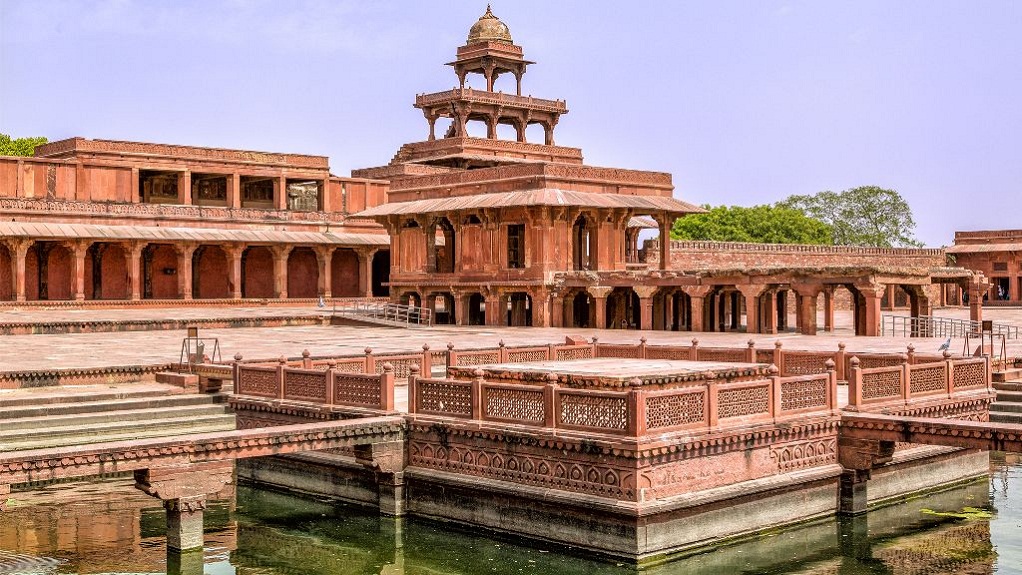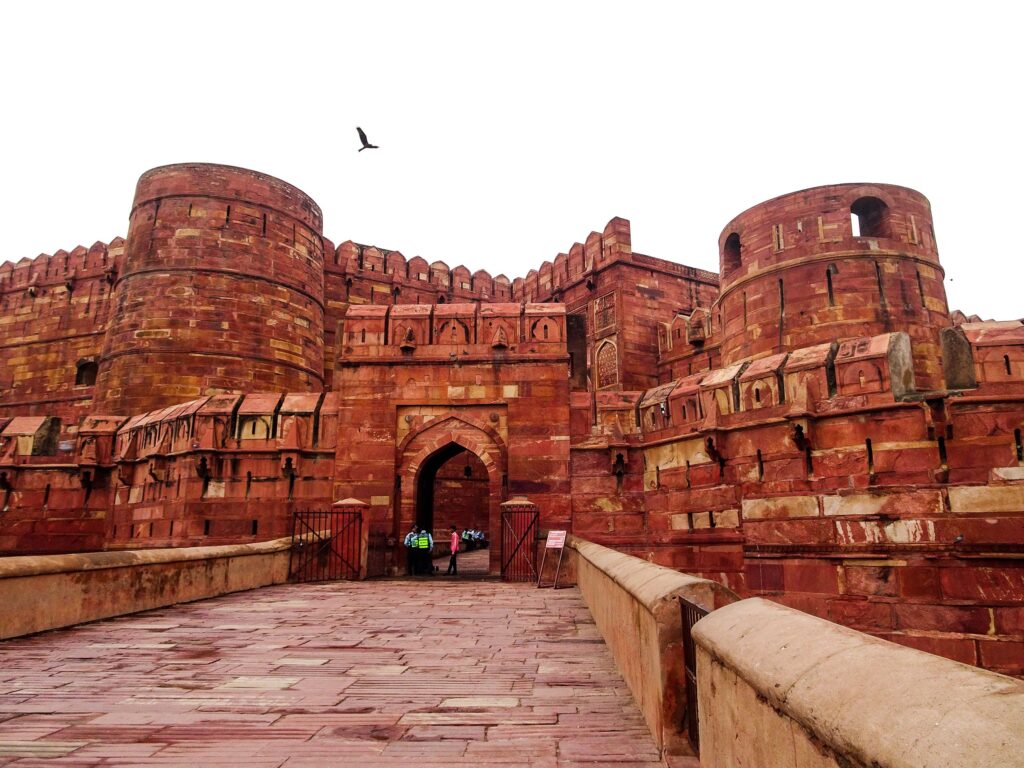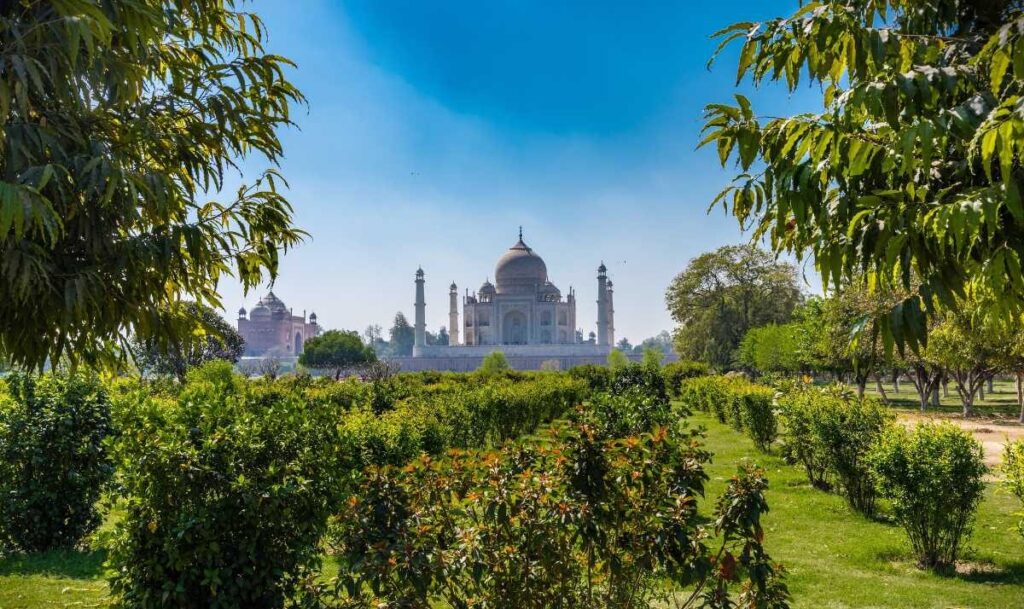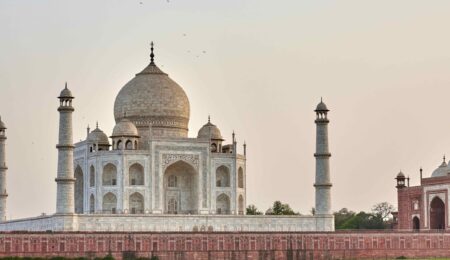 Fatehpur Sikri:
Fatehpur Sikri:
Fatehpur Sikri is a stunning reminder of the magnificence and magnificence of the Mughal period that is interwoven into India’s historical fabric. Located on the outskirts of Agra, this UNESCO World Heritage site tells stories of ancient civilizations and reverberates with the footsteps of royalty who have entered its sacred grounds.
Entering Fatehpur Sikri is like stepping into a bygone age, when the Indian subcontinent was under the dominion of the Mughal Empire. Founded in the late 16th century by Emperor Akbar, this once-thriving metropolis briefly but gloriously served as the capital of the empire.
Every turn leads to a new architectural and design wonder at Fatehpur Sikri, instilling a feeling of wonder as one makes their way through the maze-like streets. The city’s magnificent palaces, elaborate mosques, and beautifully carved gates portray a harmonic fusion of Persian, Hindu, and Islamic art.
One of the biggest mosques in India, the magnificent Jama Masjid is located in the middle of Fatehpur Sikri. It is a work of Mughal grandeur. An astonishing symphony of colour and texture is achieved by the mosque’s construction from red sandstone and white marble, which is embellished with intricate carvings and inlaid with valuable stones.
Across the street from here you can see the towering Buland Darwaza, also known as the “Gate of Magnificence,” which is the entry to the city. The Buland Darwaza, constructed to mark Akbar’s triumph over Gujarat, is a monument to the majesty and military might of the Mughal emperor.
As one continues their exploration, they come across the magnificent Panch Mahal, a palace with five stories that was formerly the emperor’s and his courtiers’ refuge. The Panch Mahal showcases the Mughals’ architectural genius with its open pavilions and elaborately carved columns, providing breathtaking vistas of the landscape beyond.
The nearby Diwan-i-Khas, also known as the “Hall of Private Audience,” is a sight to behold because to its ornately carved jali screens and marble pillars. In this palatial setting, befitting an emperor, Akbar had secret meetings with his advisors to discuss state affairs.
One can’t help but feel awe and respect for the rich history and tradition that surround Fatehpur Sikri as the sun sets, bathing the ancient stones in a golden light. Even though Fatehpur Sikri is in ruins now, the memory of it will always be with those lucky enough to have walked in its footsteps.
Last but not least, Fatehpur Sikri is an enduring symbol of India’s cultural legacy and a tribute to the magnificence and splendour of the Mughal century. This old city is a veritable time machine, with imposing mosques and opulent palaces that tell stories of glory past and entice tourists to step into another era.
 Itmad-ud-Daulah’s Tomb:
Itmad-ud-Daulah’s Tomb:
The Itmad-ud-Daulah’s Tomb, a magnificent example of Mughal architecture, is located in the old city of Agra on the banks of the peaceful Yamuna River. This mausoleum, which gives visitors a look into the luxurious Mughal Empire, is a popular attraction in Agra and is affectionately called the “Baby Taj” due to its delicate beauty and skilled construction.
The Itmad-ud-Daulah’s Tomb is a magnificent piece of Agra’s architectural legacy; Nur Jahan, wife of Emperor Jahangir, commissioned it to honour her father, Mirza Ghiyas Beg. Among the many Mughal mausoleums in the area, this immaculate marble structure stands out for its exquisite proportions, delicate inlays, and elaborate sculptures. Construction began in 1622 and lasted until 1628.
As one draws near the tomb, a sunlit symphony of intricate decorations and white marble awaits. Craftspeople painstakingly carved elaborate floral designs, arabesques, and calligraphic inscriptions into the mausoleum’s façade, achieving an air of ethereal beauty and harmony.
One feels a profound sense of peace and respect as they enter the mausoleum through its arched entryway. Beautiful jalis, which are lattice screens made of marble, embellish the inner chambers and filter the sunlight to provide a captivating interplay of shadows and light. Intricate inlays made of valuable stones like jasper and onyx glisten like jewels in the gentle afternoon light, and delicate flower designs adorn the walls and ceilings.
The main tomb of Mirza Ghiyas Beg is encircled by lesser tombs that are erected in honour of his relatives. The exquisite dome that tops the central chamber is a testament to the skill and artistry of the Mughal artisans who worked relentlessly to produce this architectural marvel. Its elaborate geometric patterns and floral motifs are a true reflection of their work.
Fragrant flowers and cascading fountains embellish the well-kept gardens that surround the monument. As one walks along the lush walkways, the calming sound of the Yamuna River provides a tranquil background, lulling tourists into a state of tranquilly.
Even though it is dwarfed by the neighbouring Taj Mahal, the tomb of Itmad-ud-Daulah stands tall as a monument to unending dedication and affection. In order to honour her late father and ensure that his legacy would live on for years to come, Nur Jahan supposedly gave her all to the building of this mausoleum.
As a final point, the Itmad-ud-Daulah’s Tomb provides evidence of the Mughal Empire’s architectural and creative prowess. Its delicate beauty and classic grace are a constant reminder of Agra’s cultural wealth and the lasting impact of the Mughal rulers who formerly lived here.
 Agra Fort:
Agra Fort:
The Agra Fort, a magnificent reminder of the might and magnificence of the Mughal Empire, is situated on the banks of the Yamuna River. This UNESCO World Heritage site in India’s ancient city of Agra is a monument to the enduring power of human spirit in the face of adversity; it stands as a testament to the ebb and flow of empires and the passage of centuries.
Impressive walls, magnificent gateways, and elaborate palaces define the Agra Fort, a wonder of Mughal architecture built mostly of red sandstone. The Mughal emperors’ primary home, built by Akbar in the 16th century and later enlarged upon by his successors, notably Shah Jahan, offered both protection and riches to those who dwelled behind its imposing walls for generations.
The fort’s enormous walls, which extend over two km in circumference, make an impressive first impression as tourists approach. Stepping through the majestic gates—including the world-famous Delhi Gate and the equally famous Amar Singh Gate—transports one to a bygone age of mighty empires, where the very stones bear witness to the tales of conquest and triumph.
Inside the fort, sightseers are treated to a kaleidoscope of architectural beauty. In the expansive courtyard known as the Diwan-i-Aam, also known as the Hall of Public Audience, the emperor would hold court and address the complaints of his subjects. While providing breathtaking views of the cityscape, its pillared halls and beautifully carved arches testify to the ostentation and grandeur of Mughal court life.
Next to the Diwan-i-Aam is the Diwan-i-Khas, also known as the Hall of Private Audience, where the emperor would privately meet with foreign dignitaries to discuss state affairs. The hall is a reflection of the opulence and refinement of the Mughal court, with its marble pillars, precious stone inlay, and elaborate decorations.
Delving deeper into the fort reveals a maze of pavilions, gardens, and palaces that were formerly the personal quarters of the Mughal emperors and their family. The Private Palace, also known as the Khas Mahal, is an architectural marvel that exemplifies Mughal perfection. Its magnificent floral designs, delicate marble screens, and elaborate balconies convey an air of classic beauty.
The Sheesh Mahal, also known as the Palace of Mirrors, is close by and is sure to impress with its glistening walls decorated with hundreds of miniature mirrors that reflect the light in a spectacular display of glimmer and lustre. Legend has it that the palace would beg people to look upon it on a moonlit night because of the hypnotic spell it cast.
You can’t help but be humbled by the rich legacy and historical significance of the Agra Fort as you watch the sun go down over the Yamuna River and illuminate its walls with a golden light. Despite the passage of time, the fort continues to stand as a representation of India’s cultural heritage and a monument to the lasting impact of the Mughal Empire.
 The Mehtab Bagh:
The Mehtab Bagh:
The Mehtab Bagh is a little-known jewel in Agra that sits peacefully on the banks of the Yamuna River, just next to the famous Taj Mahal. The “Moonlight Garden,” a lush haven, is a reflection of the Mughal love of order, aesthetics, and careful landscaping.
There is an immediate feeling of calm and peace when entering the Mehtab Bagh. As they look out into the carefully tended gardens, they can make out the verdant foliage and bright pops of colour from the many flowers in bloom. Cool shade from towering trees and the delicate aroma of roses and jasmine waft through the air.
Undoubtedly, the Mehtab Bagh’s most prominent feature is its breathtaking vista of the Taj Mahal, which is situated across the river. A picture of unmatched beauty and serenity unfolds as the sun rises over the horizon, lighting up the marble mausoleum with its golden light. The Yamuna River reflects the Taj Mahal, adding to the serene setting.
The Mehtab Bagh was initially intended to be one of eleven gardens that extended along the riverfront and was built during Emperor Babur’s reign in the early 1600s. However, the garden was enlarged and ornamented to provide the ideal vantage point for admiring the famed structure during the time of Emperor Shah Jahan, who built the Taj Mahal.
As one makes their way around the Mehtab Bagh, they will come across a number of pavilions, fountains, and water channels that were formerly the location of magnificent Mughal garden celebrations and ceremonies. Shaded from the sun and offering breathtaking views of the scenery, the pavilions are adorned with delicate lattice screens and elaborate marble carvings.
As the day goes on and the sun goes down, the Mehtab Bagh gets even more magical. As the sun sets and the sky turns a beautiful shade of pink and gold, the Taj Mahal is illuminated by the gentle light of the setting sun, which creates a mesmerising radiance on its shimmering white marble exterior. In the late afternoon and early evening, the Mehtab Bagh takes on an otherworldly quality that makes its natural beauty and romanticism stand out.
The Mehtab Bagh has been a representation of the everlasting devotion that served as the impetus for building the Taj Mahal for many years. Here, the grandeur of the Mughal Empire’s architecture harmonises harmoniously with the majesty of nature, and it appears as though time has stood still.
Leaving the Mehtab Bagh and its breathtaking views brings back thoughts of a place where love is in the air and where beauty has no limits. In this symphony of colour, scent, and everlasting beauty, the past and present meet, and Agra’s enduring charm is on full display.

The Jama Masjid:
The Jama Masjid stands tall in the middle of Agra, amid the old lanes and crowded streets, representing the city’s spiritual and architectural beauty. As a symbol of India’s cultural wealth and the lasting influence of the Mughal Empire, this famous mosque is a work of art in Mughal architecture.
Jama Masjid is an exquisite example of 17th-century symmetry, proportion, and design, and it was commissioned by Emperor Shah Jahan. The mosque, which is mostly made of white marble and red sandstone, has an air of majesty and grandeur that draws everyone who sees it.
As one draws near the Jama Masjid, the sight of its majestic domes, towering minarets, and elaborately carved arches is enough to take one’s breath away. With its exquisite flower themes and elaborate writing, the main entryway leads you into a realm of architectural beauty and spiritual enlightenment.
There is an air of quiet reverence the moment one steps inside the Jama Masjid courtyard. With its expansive marble pavement, graceful water channels, and shady alcoves, this hallowed space beckons worshippers to pause and reflect.
Intricate marble screens, called jalis, refract the sunlight to produce a captivating dance of light and shadow in the prayer hall, a vast chamber in the centre of the mosque. As worshippers direct their prayers towards the Almighty from the mihrab, or prayer niche, they are greeted by intricate carvings and Quranic inscriptions.
Intricate marble carvings and beautiful calligraphy adorn each of the smaller chambers and alcoves that surround the prayer area. These rooms, which the faithful previously utilised for prayer and reflection, now stand as a tribute to the skill and artistry of the Mughal builders who toiled away at this architectural marvel.
Ascending the Jama Masjid’s minarets offers breathtaking views of the city below and beyond, including the beautiful domes and spires of Agra in the distance. This is the best spot to take in the mosque’s massive size and the ever-changing splendour of the city that surrounds it.
The Jama Masjid is filled with believers who gather to offer prayers to the Divine as the call to prayer sounds through the halls. A spiritual transcendence that knows no bounds permeates the atmosphere as the aroma of incense and the sound of recitation fill the air.
The Jama Masjid has been a unifying symbol and a lighthouse of faith for the Agra community for generations. People from many walks of life gather there to pray and find comfort, wisdom, and direction from the Divine.
As visitors leave the Jama Masjid, they take with them the memory of a sacred space where architecture and religion harmonise in a harmonious display of reverence. This monument stands as a symbol of the Mughal Empire’s lasting influence and the irresistible charm of Agra, a city where religion, culture, and history come together to form a magnificent tapestry.





